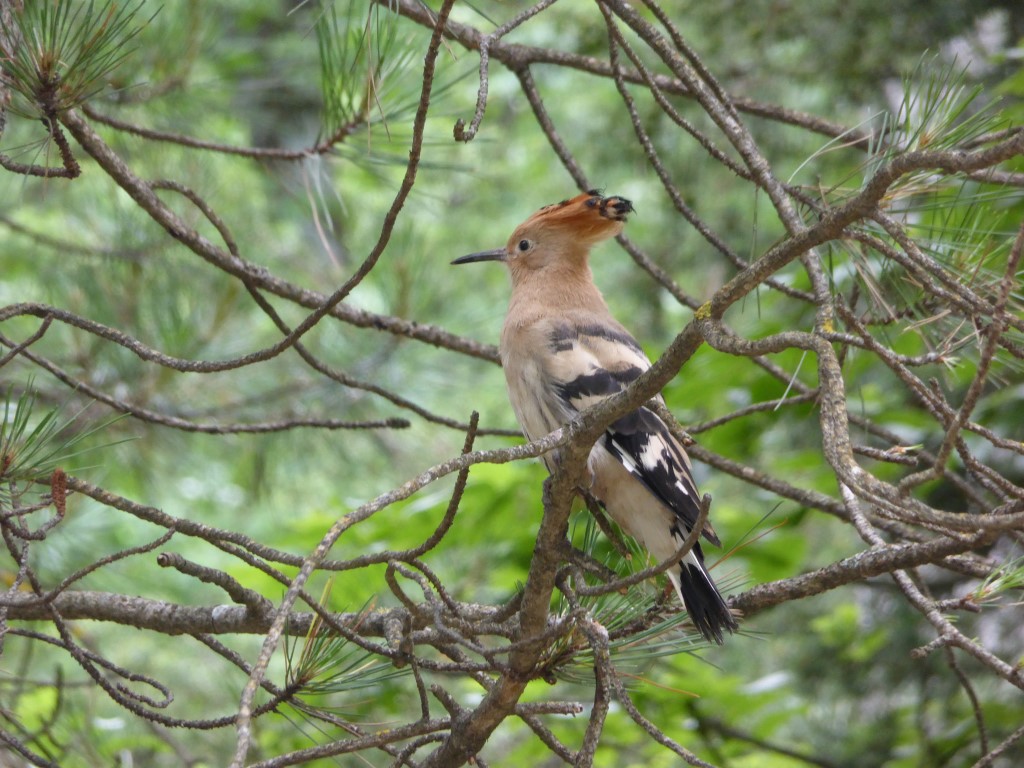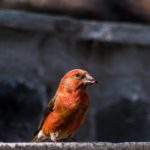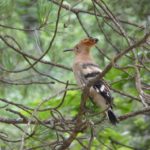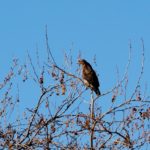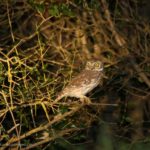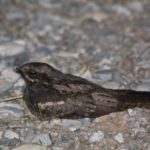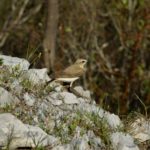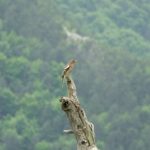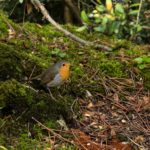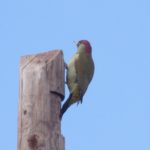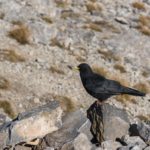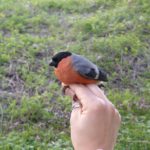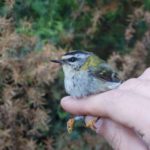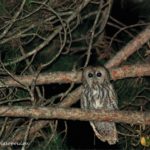Avifauna
Historically, around 150 species of birds have been recorded in the wider area of Olympus. According to the results of the program "Surveillance and assessment of the conservation status of Bird species of community interest in the jurisdiction area of Olympus National Park Management Agency"10, in the last years 135 species either inhabit or pass through the region.
Birds of prey find shelter on the steep rocky mountain slopes, including eagles (Circaetus gallicus, Aquila chrysaetos), buzzards (Buteo buteo, Pernis apivorus), hawks (Accipiter brevipes, Accipiter nisus), kestrels (Falcon naumanni, Falco tinnunculus), and falcons (Falco eleonorae, Falco peregrinus). Alpine specialists such as the impressive wallcreaper (Tichodroma muraria), the alpine accentor (Prunella collaris), the horned lark (Eremophila alpestris) and the alpine chough (Pyrrhocorax graculus) live in the alpine meadows, rocks and screes, and are adapted to difficult mountain conditions. The dense woodlands harbor a variety of woodpeckers (Dryocopus martius, Dendrocopos leucotos, D. medius, D. syriacus, Picus canus, P.viridis) and tit species (Lophophanes cristatus, Poecile montanus, Periparus ater, Poecile lugubris). Forest dwellers also include the northern goshawk (Accipiter gentilis) and the booted eagle (Hieraatus pennatus) while the area, in general, is an important migratory passage for raptors.
Of the birds found on Mount Olympus, 34 species are protected under Annex Ie of Wild Bird’s Directive 2009/147/EEC11, while others are included in the Red Data Book of Endangered Animals in Greece9.
Bird species included in the EU Directive 92/43/EEC and the Red Book of Endangered Animals of Greece
| Α/Α | SPECIES | COMMON NAME | PROTECTION STATUS |
|---|---|---|---|
| 1 | Ciconia ciconia | White stork | Annex Ι, VU |
| 2 | Ciconia nigra | Black stork | Annex. Ι, EN |
| 3 | Gyps fulvus | Griffon vulture | VU/CR |
| 4 | Αquila chrysaetos | Golden eagle | Annex Ι, EN |
| 5 | Aquila pomarina | Lesser spotted eagle | Annex Ι, EN |
| 6 | Circaetus gallicus | Short-toed eagle | Annex Ι, NT |
| 7 | Hieraaetus pennatus | Booted eagle | Annex Ι, EN |
| 8 | Milvus migrans | Black kite | Annex Ι, CR |
| 9 | Circus aeruginosus | Western marsh harrier | Annex Ι, VU |
| 10 | Circus cyaneus | Hen harrier | Annex Ι |
| 11 | Circus pygargus | Montagu’s harrier | CR |
| 12 | Buteo rufinus | Long-legged buzzard | VU |
| 13 | Pernis apivorus | European honey buzzard | Annex Ι |
| 14 | Accipiter brevipes | Levant sparrowhawk | Annex Ι |
| 15 | Falco naumanni | Lesster kestrel | Annex Ι, VU |
| 16 | Falco vespertinus | Annex Ι | Annex Ι |
| 17 | Falco eleonorae | Eleonora’s falcon | Annex Ι |
| 18 | Falco peregrinus | Peregrine falcon | Annex Ι |
| 19 | Alectoris graeca | Rock partridge | Annex Ι, VU |
| 20 | Bubo bubo | Eurasian eagle-owl | Annex Ι |
| 21 | Aegolius funereus | Boreal owl | Annex Ι |
| 22 | Glaucidium passerinum | Eurasian pygmy owl | Annex Ι |
| 23 | Caprimulgus europaeus | Eurasian nightjar | Annex Ι |
| 24 | Coracias garrulus | European roller | Annex Ι, VU |
| 25 | Dryocopus martius | Black woodpecker | Annex Ι |
| 26 | Picus canus | Grey-headed woodpecker | Annex Ι, NT |
| 27 | Dendrocopos leucotus | White-backed woodpecker | Annex Ι |
| 28 | Dendrocopοs medius | Syrian woodpecker | Annex Ι |
| 29 | Dendrocopοs syriacus | Eurasian three-toed woodpecker | Annex Ι, NT |
| 30 | Picoides tridactylus | Woodlark | Annex Ι |
| 31 | Lullula arborea | Greater short-toed lark | Annex Ι |
| 32 | Calandrella brachydactyla | Calandra lark | VU |
| 33 | Melanocorypha calandra | Tawny pipit | Annex Ι |
| 34 | Anthus campestris | Collared flycatcher | Annex Ι |
| 35 | Ficedula albicollis | Collared flycatcher | Annex Ι |
| 36 | Ficedula semitorquata | Semi-collared flycatcher | Annex Ι |
| 37 | Lanius collurio | Red-backed shrike | Annex Ι |
| 38 | Lanius minor | Lesser grey shrike | Annex Ι |
| 39 | Emberiza hortulana | Ortolan bunting | Annex Ι |
CR= Critically endangered
ΕΝ= Endangered
VU= Vulnerable
NT= Near threatened
a Priority habitats / Species: Natural habitats and species that are in danger of disappearance for the conservation of which the Community has particular responsibility in view of the proportion of their natural range which falls within its territory. They are denoted by an asterisk (*) in Annexes I and II and special measures apply to them.
b Annex I Habitat types of EU Habitat’s Directive 92/43/EEC: Natural habitat types of community interest whose conservation requires the designation of special areas of conservation.
c Annex II Species of EU Habitat’s Directive 92/43/EEC: Animal and plant species of community interest whose conservation requires the designation of special areas of conservation.
d Annex IV Species of EU Habitat’s Directive 92/43/EEC: Animal and plant species of community interest in need of strict protection.
e Annex Ι species of EU Wild Bird’s Directive 2009/147/ΕEC: Species that are subject to special conservation measures concerning their habitat in order to ensure their survival and reproduction in their area of distribution.
1 «Specialized Environmental Study of Olympus National Park» (2010). Ministry of Environment, Energy and Climate Change, Dept. of Environmental Planning, Division for the Management of the Natural Environment.
2 Tsitsoni Th., Fotiadis G., ELKE-AUTH (2015). «Surveillance and evaluation of the conservation status of Habitat Types of European Community Interest in the area of jurisdiction of Olympus National Park Management Agency». Phase D’. ONPMA, RDP Macedonia-Thrace 2007-2013.
3 Council Directive 92/43/EEC “On the Conservation of Natural Habitats and of Wild Fauna and Flora”.
4 Strid, A. (1980). Wild Flowers of Mount Olympus. Goulandri Natural History Museum, Athens.
5 Tsitsoni Th., Fotiadis G., Tsitinis G., ELKE-AUTH (2015). «Surveillance and evaluation of the conservation status of Plant species of European Community Interest in the area of jurisdiction of Olympus National Park Management Agency». Phase D’. ONPMA, RDP Macedonia-Thrace 2007-2013.
6 Sokos, Ch., Birtsas P., Hatzinikos E., Bontzorlos V., Papaspyropoulos, Κ., et al., TECHNOOMOIOSTASI-YLORIKI-LOUVITAKIS (2015). «Surveillance and evaluation of the conservation status of Mammals of European Community Interest in the area of jurisdiction of Olympus National Park Management Agency». Phase D’. ONPMA, RDP Macedonia-Thrace 2007-2013.
7 Olympus National Park Management Agency (2017). Technical Report 2016 on the Monitoring of Environmental Parameters, Litochoro.
8 Olympus National Park Management Agency (2016). Technical Report 2015 on the Monitoring of Environmental Parameters, Litochoro.
9 Legakis, A. & Maragou, P. (2009). The Red Book of Endangered Animals of Greece.Hellenic Zoological Society, Athens.
10 Bousbouras, D. & YETOS Ο.Ε. (2015). «Surveillance and evaluation of the conservation status of Birds of European Community Interest in the area of jurisdiction of Olympus National Park Management Agency». Phase D’. ONPMA, RDP Macedonia-Thrace 2007-2013.
11 Directive 2009/147/EC of the European Parliament and the Council of 30 November 2009 “On the Conservation of Wild Birds”.
12 Ioannidis I., Papamichail G., GEOANALYSIS Α.Ε. (2015) «Surveillance and evaluation of the conservation status of Amphibians & Reptiles of European Community Interest in the area of jurisdiction of Olympus National Park Management Agency». Phase D’. ONPMA, RDP Macedonia-Thrace 2007-2013.
13 Pamperis, L. (2009). The Butterflies of Greece. 2nd edition, PAMPERI & ΚΟΑΝ publishers, Athens. Website www.pamperis.gr for updates on the book.
14 Avtzis D., Kaltsas D., TECHNOOMOIOSTASI-YLORIKI-LOUVITAKIS (2015) «Surveillance and evaluation of the conservation status of Invertebrates of European Community Interest in the area of jurisdiction of Olympus National Park Management Agency». Phase D’. ONPMA, RDP Macedonia-Thrace 2007-2013.
15 Presidential Decree 67/1981 (Hellenic Government Gazette No. 23 Α’/30-1-1981) “On the protection of native flora and wild fauna and the procedures for the coordination and control of their research”.
16 Heath, J. (1981) Threatened Rhopalocera (butterflies) of Europe. Council of Europe.
17 Tolmann, T. & Lewington, R. (2008). Collins Butterfly Guide: The Most Complete Field Guide to the Butterflies of Britain and Europe. 3rd Edition, HarperCollins UK.
18 Speight M.C.D. (1989). Saproxylic invertebrates and their conservation. Council of Europe.


